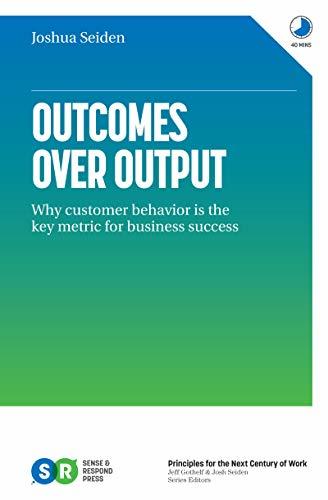
Review
I have heard many product managers say “outcomes over output,” but few have a clear definition of an outcome. Defining an outcome as a change in behavior that drives business results is key to linking this principle to product practice. It anchors to the core of product management, which is all about the value exchange between customers and the business. The author does an excellent job of taking a great product management principle and almost creating a full-stack product management model based on it. Changes in behavior are observable and measurable. Customer behavior can be visualized on a customer journey map. Executives can hold teams accountable for hitting outcomes. Businesses can be transformed by using the same techniques.
Key Takeaways
The 20% that gave me 80% of the value.
- An outcome is a change in behavior that drives business results
- Don’t focus on your output, focus on outcomes and changing human behavior
- Features don’t automatically create value → so don’t use them as the center of your planning process
- Managing outputs → telling a team what to build
- BUT features don’t always deliver value
- Managing impact → telling a team to target some high-level value (growing revenue)
- BUT that’s not specific enough
- Managing outcomes → ask teams to create a specific human behavior that drives business results
- Gives them room to find the right solution, and keeps them focused on delivering value
- Agile doesn’t tell us what ‘value’ means
- Setting outcome goals → gives teams room to try different approaches and experiment
- Think of MVP as the smallest thing you can do (or make) to learn if your hypothesis is correct
- There are only 5 things executives care about (by Jared Spool). These are impact-level metrics
- Increasing revenue
- Decreasing costs
- Increasing new business and market share
- Increasing revenue from existing customers
- Increasing shareholder value
- Finding the right outcome:
- What are the customer behaviors that will drive business results?
- What are the the things customers do that help us predict the thing we care about
- Because outcomes are things people do, they’re observable and measurable. Making them suitable to be used as a management tool
- Understand what your customers are doing that drives the results you care about
- Leading vs Lagging indicators:
- What is a leading indicator?
- Things people are doing (human behavior)
- They predict the success we’re seeking
- Leading indicators are therefore outcomes
- What is a leading indicator?
- Hypothesis
- There’s uncertainty when we create outcomes:
- Will the output create the outcome?
- Will the outcome contribute to the impact?
- Treat ideas like assumptions. Express assumptions as hypothesis. Run experiments to test hypothesis.
- Hypothesis: What we believe & the evidence we’re seeking (to know if we’re right or not)
- There’s uncertainty when we create outcomes:
- The Magic Questions
- What are the user and customer behaviors that drive business results?
- How can we get people to do more of those behaviors?
- How do we know that we’re right?
- Tracking progress is easier when teams are working on well defined outcomes and making their hypothesis clear. They are measurable → Are customer behaviors changing?
- Outcomes help you write better OKRs → first consider the business result you’re trying to achieve, express that in easy-to-measure terms of customer behavior
- Think about your system of outcomes
- Outcome-based roadmaps
- Visualize the customer journey → what are people doing (customer, colleague, other players)
- What behaviors at each step predict success and satisfaction?
- And what behaviors at each step predict failure and dissatisfaction?
- Write down and overlay success factors (boosters) and failure factors (blockers)
- How might we encourage x?
- How might we eliminate issue y?
- Frame as a hypothesis:
We believe that if we increase the rate at which buyers and sellers meet early in the process, it will lead to more successful transactions (as measured by X) and higher user satisfaction (as measured by NPS.)
We think we can increase the rate of early meetings [with this idea] and [with this idea] and [with this idea.] We will work on testing these ideas in Q1 of the coming year.
- Organizations are often setup in products/channels vs behaviors/customer journeys
- Doing so favors outputs not outcomes
- Teams should be clear about the value they are trying to create. They should specify:
- the outcome they are seeking for the customer or user
- the outcome they are seeking for the business
- If we create this outcome for the user → it will deliver this outcome for the business.
- Product managers should have dedicated teams, else they end up waiting to be allocated a team before they can start work
- If stakeholders have to wait a long time for their project to be approved, they bloat their feature requirements, force everything in they need.
- Companies might have to re-engineer the way they work in order to implement outcomes in their work
- How can we change employee behavior in a way that generates business results?
- Apply an outcome-based approach to transformation:
- Your colleagues are your customers
- Everything is an outcome
- Everything is an experiment
- Take a customer-centric approach with your colleagues
- What are their goals? What value can you offer to them in order to get them to “buy” the change you are selling?
- Frame organizational change initiatives in terms of outcomes.
- What are the new behaviors you want to create in the organization?
- What will people be doing differently when your change program is successful?